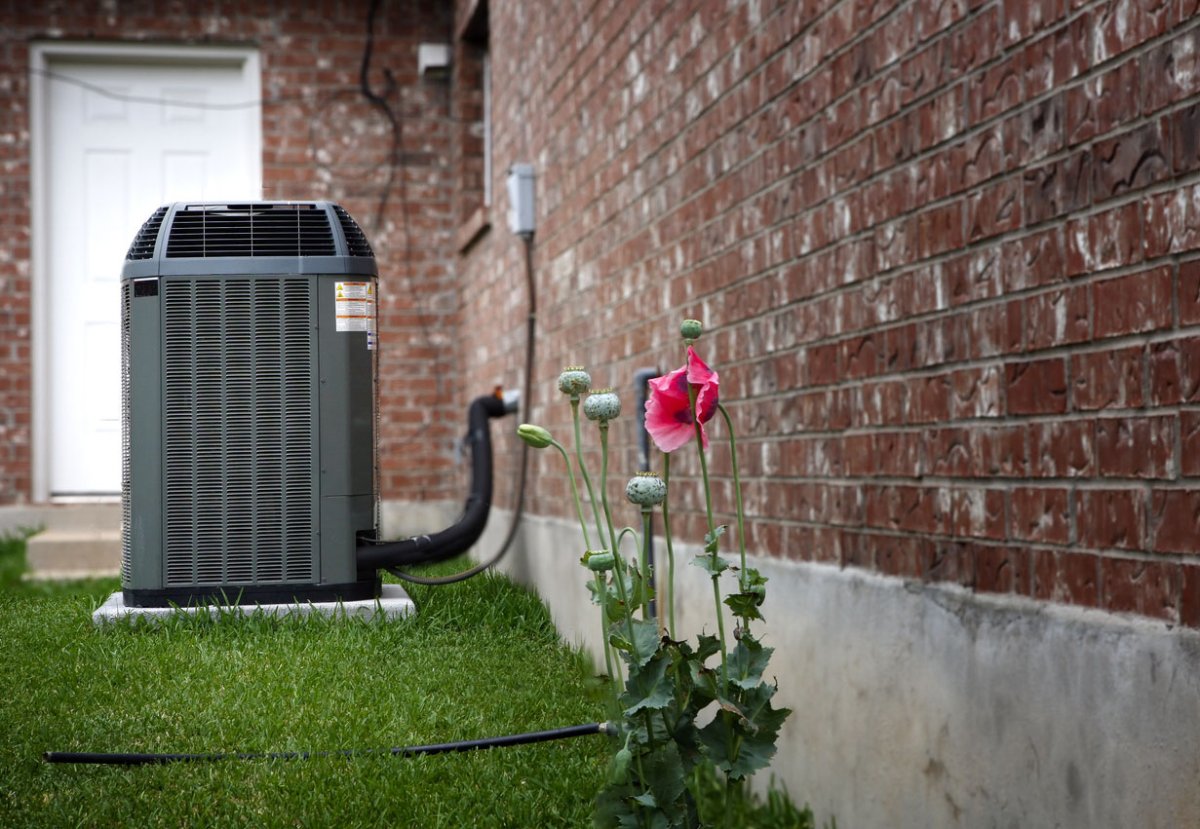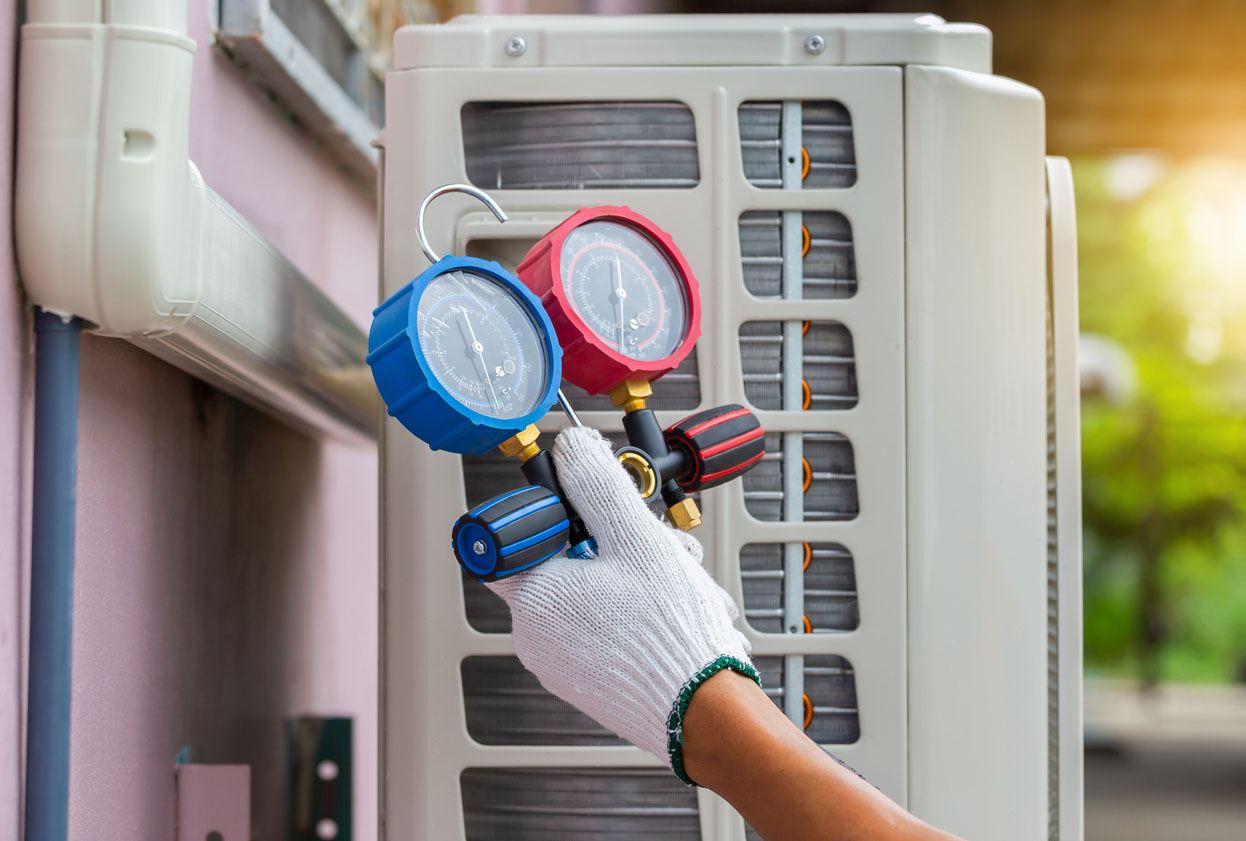

We may earn revenue from the products available on this page and participate in affiliate programs. Learn More ›
What You Need to Know
- There are several reasons an AC unit might not be blowing cold air.
- Common causes include a faulty thermostat, a dirty filter, a malfunctioning condenser or evaporator coil, or a clogged drain.
- Other potential issues include a dirty compressor, a blocked register, a low refrigerant level, damaged ductwork, or an incorrectly sized AC unit.
- An HVAC professional can diagnose and fix the issue and get the AC unit blowing cold air again.
Q: Help! We’ve just had our first heatwave and we want to cool the house—but our central AC is not blowing cold air. I’ve turned the thermostat on and off, but it’s still not cooling the house. Is there another simple fix I can try to get it working today, or do I need to call an HVAC company?
A: A broken central AC unit is a huge inconvenience, especially in hot climates. Reliable cool air is necessary in some parts of the country, and an AC not working can make life miserable. Malfunctioning thermostats, dirty filters or compressors, and low refrigerant levels are just a few of the culprits for an AC not blowing cold air. HVAC systems last for about 15 to 25 years before the compressor wears out, but if the unit isn’t that old, then a few common solutions might just get it working again. Homeowners who are wondering “why is my AC not blowing cold air?” can try to diagnose the problem with the following troubleshooting tips. They’ll also want to make sure to have the number of one of the best HVAC companies handy in case the issue is more complex.
There could be a problem with the power source preventing the unit from turning on.
AC units pull a lot of power to kick on the motor. It’s possible that the initial power surge tripped the breaker or blew a fuse. If this is the problem homeowners may also notice that the AC unit fan is not spinning or the outside AC unit is not turning on at all. They can try resetting the breaker and turning the AC on again to see if that solves the problem. It’s also a good idea to see if the motor has a built-in overload switch that needs to be reset. Lastly, they can take a quick look at the power cord to ensure it didn’t get pulled out of the socket.
The thermostat may be calibrated incorrectly or not working properly.
After checking the power settings, homeowners will want to make sure the thermostat is working. Does it seem like the AC is blowing hot air? They can make sure that the thermostat was not accidentally switched to heat or auto. If it uses batteries, they can try changing them to see if the thermostat will respond to the controls again. The next step is turning the cooling setting down lower than usual to try forcing the system to run cold air for a short period. Some systems also have an automatic setting that can prevent the system from running. Homeowners can switch to a manual mode or override the temperature setting to get the system to blow cool air again.
The filter may be dirty and need to be cleaned or replaced.
Central AC units rely on easy access to circulated air to return refrigerated air to the house. These air returns have filters to prevent dust and dander from being recirculated into the house. If the air filter hasn’t been replaced recently, it’s possible that the motor shut down since it couldn’t suck in sufficient air and overheated. If this happens repeatedly it can cause serious damage to the unit. Homeowners will want to check the air filter and replace it if it is too clogged to see through or if it’s gray or brown. If the filter is washable, they’ll want to make sure to clean and scrub it thoroughly before trying to turn on the AC again. Most professionals recommend doing this once every 30 to 90 days; changing the filter is one of the best things homeowners can do for their AC system.
There could be issues with the condenser or evaporator coil.
The evaporator coil and condenser are the parts of the AC unit that convert hot air into cool, allowing cold air to flow back into the home. If the unit is leaking refrigerant, the system may try to compensate by going into overdrive, causing the coils to freeze. If this part of the AC unit is accessible, homeowners can inspect it for frost buildup. If the evaporator coil is frozen, an HVAC professional will need to inspect it and replace the unit’s refrigerant if needed.
The drain might be clogged and need to be cleaned.
Central AC units are designed to blow cool air while removing humidity and moisture from the house. Each unit has a drainpipe to collect this excess moisture, but as with most cool, dark pipes that don’t get flushed frequently, debris and algae could build up and prevent moisture from draining. Clogging can also be a symptom of the system repeatedly shutting down due to another issue. While it’s inconvenient, it’s a helpful safety feature since it prevents the AC unit from allowing filthy water to backflow into the house. A pro will be more than capable of identifying and cleaning a clogged drain quickly, and this kind of HVAC service costs about $100 on average.

The compressor might be dirty or blocked by debris.
There are two parts to a central AC unit: the condensing motor inside the house and the compressor outside the house. Compressors need to be covered tightly during winter months to prevent debris or snow from building up inside the unit. Homeowners can check the compressor to make sure the interior is free of leaves and dirt. If vines are growing on the unit, it’s important to remove them so the unit can operate freely. Homeowners can also ensure toys and towels aren’t stored on top of the unit so the fans can operate at peak capacity without overheating. Compressor leaks can also happen and usually result in the compressor freezing up until the leak is repaired. If the compressor has reached the end of its lifespan and needs to be replaced, a brand-new AC compressor costs $1,200 on average. This is one of the most costly AC repairs, so if applicable, it may be worth homeowners checking whether their home warranty covers HVAC before scheduling this service.
The registers could be blocked or clogged.
If the airflow problem seems isolated in just one part of the home, or the AC is running but not cooling in one room, a register in that area could be blocked. This problem can often be remedied easily and with no AC repair costs at all. First, homeowners can check to make sure that furniture, decor, or other objects are not blocking airflow from any registers in the room (don’t forget registers on the walls and ceiling as well as the floor). If it still seems like the AC is not cooling after these areas are clear, there may be something blocking airflow from inside the register or the vent cover may need to be cleaned. In most cases, it is easy to remove the vent cover with a screwdriver to clean it or check inside the vent.

The refrigerant level may be too low and need to be refilled.
HVAC systems use refrigerant (also called coolant) to cool hot air before sending it back to circulate throughout the home. The amount of coolant doesn’t reduce over time, but if there’s a leak, then the system may not have enough to blow cold air into the house, leaving homeowners wondering, “Why is my central AC running but not blowing air?” In this case, the leak must be fixed to solve the problem, but homeowners won’t want to attempt this without a professional. In the past, AC units used a chemical coolant known as Freon, but the use of this chemical in new AC units was banned by the EPA in 2020. Freon is still being phased out, so homeowners whose systems may still run on this type of coolant may want to consider upgrading. HVAC unit replacement costs about $7,000 on average. Most new systems run on an alternative chemical called Puron. An HVAC professional will have the tools to find and repair any refrigerant leaks, then refill the coolant to get the house back to a comfortable, cool temperature. Even if there is no leak, sometimes pros will recommend an AC recharge, which involves replacing the chemicals in the unit with fresh refrigerant. A home AC recharge costs an average of $300.
- Freon (R-22) is now banned by the EPA due to its harmful effects on the ozone layer. Some older HVAC units still run on Freon and can be identified by a green container that sits alongside the outdoor unit. The compressor unit will also be labeled with the refrigerant type.
- Puron (R-410A) is a refrigerant that is easier on the environment, more efficient, and produces better air quality than Freon. It is now the dominant refrigerant type since Freon was banned in 2020. HVAC units that run on Puron have a pink tank and will also be labeled accordingly.
The ductwork might be damaged and leaking.
After being cooled, air must travel through ductwork in order to be distributed through the home. If the AC is blowing warm air, leaky ductwork is a likely candidate. Leaks or punctures in the ductwork can cause cool air to escape and warm air to take its place, resulting in the AC unit not blowing cold air. Leaks can happen if ductwork is old, installed incorrectly, or has interference from pests and rodents. These issues will need to be addressed by a professional HVAC technician. One way for homeowners to troubleshoot whether damaged ductwork is to blame is to hold a lit stick of incense and run it along the outside of the ducts. If the smoke is blown away from the duct at any point, there is likely a leak in that spot. It may be necessary to have one of the best AC installation companies put in new ductwork.
The AC unit may be too small to handle the cooling needs of the home.
While a small unit may be sufficient for mild spring weather, it will struggle to keep up as temperatures increase throughout the summer. If this is the case, it may be necessary for the homeowner to upgrade to a more powerful system. On average, a new central AC unit costs about $5,860. Homeowners shopping for a new AC unit may also want to look into the best home warranties for HVAC (such as American Home Shield and Liberty Home Guard) to protect themselves from the cost of future repairs. AC size is measured in British thermal units (BTUs) per hour. As a general rule, taking the square footage of a home and multiplying it by 25 will provide the unit size needed to sufficiently cool a home. Alternatively, an HVAC professional can advise homeowners on what size system they need.
